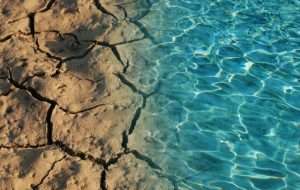 When asked to name the most important environmental issue facing the state today, Californians are most likely to mention water supply and drought—a shift from a year ago. About six in ten Californians approve of Governor Newsom’s handling of environmental issues, and a similar share approve of President Biden on the environment. Overwhelming majorities of Californians—including majorities across partisan groups—believe that developing alternative energy sources should be prioritized over expanded use of oil, coal, and natural gas in the nation’s energy supply. These are among the key findings of a statewide survey released today by the Public Policy Institute of California.
When asked to name the most important environmental issue facing the state today, Californians are most likely to mention water supply and drought—a shift from a year ago. About six in ten Californians approve of Governor Newsom’s handling of environmental issues, and a similar share approve of President Biden on the environment. Overwhelming majorities of Californians—including majorities across partisan groups—believe that developing alternative energy sources should be prioritized over expanded use of oil, coal, and natural gas in the nation’s energy supply. These are among the key findings of a statewide survey released today by the Public Policy Institute of California.
One in four Californians (25% adults, 26% likely voters) say that water supply and drought is the most important environmental issue facing the state. Smaller shares named wildfires (17% adults, 18% likely voters), climate change (13% adults, 16% likely voters), and air pollution and vehicle emissions (6% adults, 5% likely voters). Last July, fewer Californians—10% adults, 11% likely voters—pointed to water supply and drought as the top environmental issue facing the state; instead, climate change was most likely to be named as most important.
“Water and the drought has jumped to the top of the list when Californians are asked to name the most important environmental issue facing the state today,” said Mark Baldassare, PPIC president and CEO.
Most Are Very Concerned about the Impact of Climate Change on Droughts and Wildfires
Strong majorities (68% adults, 70% likely voters) believe the effects of climate change have already started. One in ten or fewer (8% adults, 10% likely voters) believe the effects of climate change will never happen. Views are divided along partisan lines, with 82 percent of Democrats and 68 percent of independents saying the effects of climate change are already underway, compared to 44 percent of Republicans. Across racial/ethnic groups, solid majorities say the effects have already begun (69% Latinos, 67% whites, 66% Asian Americans, 60% African Americans). In a March Gallup national survey, 59 percent of American adults said the effects of climate change are already happening.
Overwhelming majorities believe that climate change is a factor in the environmental challenges now facing the state: 80% say that climate change has contributed to the current drought, and 78% say that climate change has contributed to California’s recent wildfires. Overwhelming majorities across regions and across demographic groups hold these views.
Many Californians are concerned about the future effects of climate change. Six in ten are very concerned about climate change causing both droughts and wildfires that are more severe (63% each), and about half (52%) are very concerned about more-severe heat waves. One in four (25%) are very concerned about increased sea-level rise due to climate change.
“Most Californians believe that the effects of climate change have already begun and that it is contributing to the current drought and wildfires,” Baldassare said. “Six in ten are very concerned about more-severe droughts and wildfires as a result of climate change.”
A Near-Record Share Say the Water Supply Is a Big Problem in Their Part of the State
Solid majorities (63% adults, 69% likely voters) say the supply of water is a big problem in their part of California. This includes majorities across regions (70% San Francisco Bay Area, 67% Central Valley, 60% Los Angeles, 59% Inland Empire, 57% Orange/San Diego) and across age, education, gender, income, partisan, and racial/ethnic groups. The share of adults saying that water supply is a big problem has increased by 25 points since July 2020 (38% to 63%) and is near the record high of 70 percent (September 2015).
State and local officials have asked residents to reduce water use in light of the current drought. Asked about their own household’s efforts to reduce water use, 41 percent of Californians say they have done a lot, 39 percent say they have done a little, and 20 percent say they have not taken steps to reduce use. About four in ten across regions say they are doing a lot (43% Los Angeles, 41% San Francisco Bay Area, 40% Central Valley, 40% Inland Empire, 38% Orange/San Diego).
“Majorities across the state’s major regions say that the water supply is a big problem in their part of California, while about four in ten residents say their households have recently done a lot to reduce water use in response to the current drought,” Baldassare said.
Majorities See the Threat of Wildfires as a Big Problem
More than half of Californians (55% adults, 57% likely voters) say the threat of wildfires is a big problem in their part of the state. Across regions, about half or more say it is a big problem (60% San Francisco Bay Area, 56% Inland Empire, 54% Los Angeles, 52% Orange/San Diego, 48% Central Valley).
Asked about the government’s readiness to respond to wildfires in their part of the state, one in three Californians have a great deal of confidence (33%), while about half have only some confidence (52%). Fourteen percent have hardly any confidence in the government’s readiness. Democrats (37%) are somewhat more likely than independents (28%) and Republicans (25%) to have a great deal of confidence. The share of residents with a great deal of confidence varies somewhat by region (38% Los Angeles, 37% Inland Empire, 36% Orange/San Diego, 31% Central Valley, 20% San Francisco Bay Area).
“A majority of Californians say that the threat of wildfires is a big problem in their part of California, while one in three residents have a great deal of confidence in government’s readiness to respond to wildfires where they live,” Baldassare said.
Majorities Approve of How Newsom and Biden Are Handling Environmental Issues
About six in ten Californians (59% adults, 59% likely voters) approve of Governor Newsom’s handling of environmental issues. One year ago, the governor’s approval on the environment was higher (69% adults, 67% likely voters). Today, views on the governor’s handling of environmental issues are split along partisan lines, with 84 percent of Democrats, 53 percent of independents, and 18 percent of Republicans approving. Across racial/ethnic groups, strong majorities of African Americans (70%), Latinos (68%), and Asian Americans (67%) approve, compared to 47 percent of whites.
President Biden also gets high marks on the environment, with 61 percent of California adults and 61 percent of likely voters expressing approval. As with Newsom, views are divided along partisan lines, with 89 percent of Democrats, 52 percent of independents, and 19 percent of Republicans approving. Majorities of African Americans (73%), Asian Americans (72%), Latinos (66%), and whites (52%) approve.
Californians have more trust in the state government than in the federal government on environmental issues. Nearly half (48% adults, 49% likely voters) say they can trust the state government to handle environmental issues just about always or most of the time. Only a third of adults (33%) and a quarter of likely voters (24%) trust the federal government just about always or most of the time on the environment.
“Six in ten Californians approve of the way that Governor Newsom is handling environmental issues,” Baldassare said. “President Biden has similarly positive reviews, while more express trust in the state than the federal government on environmental issues.”
Majorities across Party Lines Favor Prioritizing the Development of Alternative Energy Sources
When it comes to the nation’s energy supply, an overwhelming majority of Californians (80%) think that developing alternative energy sources—such as wind, solar, and hydrogen—should be prioritized over expanding exploration and production of oil, coal, and natural gas. Majority support for prioritizing alternative sources of energy carries across partisan lines, with 93 percent of Democrats, 78 percent of independents, and 56 percent of Republicans in favor. Overwhelming majorities across racial/ethnic groups approve of prioritizing alternative sources of energy (87% Latinos, 83% Asian Americans, 76% whites, 73% African Americans).
“Majorities across partisan groups say that developing alternative energy sources is a more important priority than expanding exploration of oil, coal, and natural gas,” Baldassare said.
Most Oppose New Offshore Drilling and Fracking—and Eight in Ten Favor Coastal Wind Power and Wave Energy
An overwhelming majority of Californians (72%) oppose more oil drilling off the California coast. Partisans are divided, with 87 percent of Democrats and 70 percent of independents opposed and 55 percent of Republicans in support. Opposition is somewhat higher in the state’s coastal regions (78% north and central coast, 74% south coast) than in its inland areas (64%).
A solid majority of Californians (63%) are opposed to the expansion of hydraulic fracturing—or “fracking”—for oil and natural gas. Views break along partisan lines: 79 percent of Democrats and 67 percent of independents oppose fracking, while 56 percent of Republicans support it.
In May, Governor Newsom announced an agreement with federal partners to open up west coast waters for offshore wind power development. An overwhelming majority of Californians (81%) are in favor of offshore wind power and wave energy projects, with support crossing partisan lines (88% Democrats, 83% independents, 75% Republicans).
“Californians express strong opposition to more oil drilling off the coast and the expansion of fracking, while there is overwhelming partisan agreement in favor of the development of wind power and wave energy projects off the coast,” Baldassare said.
About the Survey
The findings presented above are based on responses from 1,569 California adult residents. The sampling error is ±3.4 percent for the total unweighted sample. Interviewing took place from July 6–14, 2021.
This article was written by the Public Policy Institute of California (PPIC) and first appeared at https://www.ppic.org/press-release/water-supply-and-drought-are-now-californians-top-environmental-concern/.


